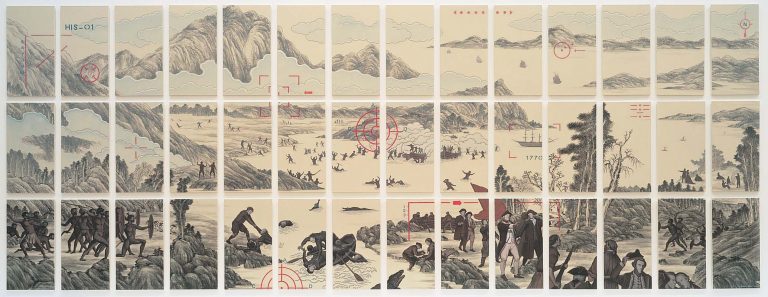We acknowledge the Traditional Owners of the land on which the Queensland Art Gallery | Gallery of Modern Art stands and recognise the creative contribution First Australians make to the art and culture of this country.

Guan Wei / China/Australia b.1957 / Echo 2005 / Synthetic polymer paint on canvas / 42 panels: 273 x 722cm (overall) / Purchased 2006. The Queensland Government’s Gallery of Modern Art Acquisitions Fund / Collection: Queensland Art Gallery | Gallery of Modern Art / © Guan Wei
Guan WeiEcho 2005
On Display: QAG, Gallery 10
In this epic work, Guan Wei reconstructs and grafts images onto the famous Chinese landscape painting Jiu Ri Shi Cheng Tu Juan by Wang Yuanqi (1641–1715). In doing so, he juxtaposes the ‘grand genre’ of European history painting of the seventeenth to nineteenth centuries with the equivalent aesthetic achievement of China during the same period — while China had become culturally introspective, Europe was aggressively expanding into other cultures through exploration and colonialism.
Guan’s use of a muted palette suggests ageing maps and historical, sepia-toned reproductions. He simultaneously draws the viewer’s attention to the contemporary meaning of the painting by inserting symbols such as telescopic weapon sights — which remind us of contemporary warfare — electronic camera viewfinders, and other visual aids from computer imagery.
Guan Wei uses these diverse elements in dialogue with each other to remind us that we are living in a time and place where cultures, technologies and races are much more integrated than in the past. The painting’s title suggests that the past continues to influence the present but will, with time, diminish like a fading echo, allowing new voices to resonate into the future.
Guan Wei was born in Beijing in 1957. He graduated from the Department of Fine Arts of Beijing Teachers’ College and became an art teacher in a middle school.
From 1989 to 1992, Guan Wei was a visiting artist at the University of Tasmania, and he commenced a twelve-month residency at the Museum of Contemporary Art in Sydney in March 1992. His work is informed by his interests in history, the environment and cross-cultural migrations.
Discussion Questions
1. Can an artwork be historical and contemporary at the same time? How does history help us with the present?
2. What role does a contemporary artist play in communicating ideas about history? What can be gained by exploring history through contemporary art?
Activities
Think of Echo as a collage; a collage of traditions, styles, images and symbols. For this activity you’ll work through a process of collage called photo-montage to design a composition that you’ll then paint into a grid.
Select a nation to research and find an image of a landscape from that nation’s tourism website that you can use as a background for a collage. Go in search of images and symbols about that nation by researching the country’s history (art, military, leaders, international relations), as well as other facets of their national story that could fill your composition (i.e. language, sport, farming, shipping). Use a grid to enlarge your image onto one large sheet of paper or card. Render your grid with your preferred medium (pencil, pastel, paint). Cut your work using your grid lines and display on a wall.